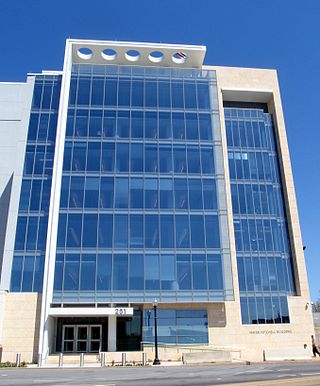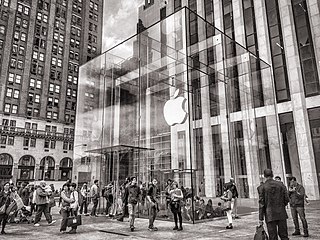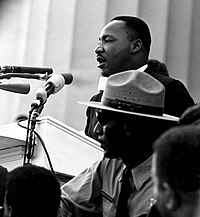
A non-governmental organization (NGO) is an organization that generally is formed independent from government. They are typically nonprofit entities, and many of them are active in humanitarianism or the social sciences; they can also include clubs and associations that provide services to their members and others. NGOs can also be lobby groups for corporations, such as the World Economic Forum. NGOs are distinguished from international and intergovernmental organizations (IOs) in that the latter are more directly involved with sovereign states and their governments.
In politics, lobbying, or advocacy, is the act of lawfully attempting to influence the actions, policies, or decisions of government officials, most often legislators or members of regulatory agencies, but also judges of the judiciary. Lobbying, which usually involves direct, face-to-face contact in cooperation with support staff that may not meet directly face-to-face, is done by many types of people, associations and organized groups, including individuals on a personal level in their capacity as voters, constituents, or private citizens; it is also practiced by corporations in the private sector serving their own business interests; by non-profits and non-governmental organizations in the voluntary sector through advocacy groups to fulfil their mission such as requesting humanitarian aid or grantmaking; and by fellow legislators or government officials influencing each other through legislative affairs in the public sector. Lobbying or certain practices that share commonalities with lobbying are sometimes referred to as government relations, or government affairs and sometimes legislative relations, or legislative affairs. It is also an industry known by many of the aforementioned names, and has a near complete overlap with the public affairs industry. Lobbyists may be among a legislator's constituencies, for example amateur lobbyists such as a voter or a bloc of voters within their electoral district acting as private citizens; others like professional lobbyists may engage in lobbying as a business or profession; while others are government relations support staff who work on behalf of professional lobbyists but do not actively participate in influencing or meeting face-to-face with targeted personnel enough to be considered registered lobbyists while working in the same professional circles as professional lobbyists who are legally designated as registered lobbyists.

A political movement is a collective attempt by a group of people to change government policy or social values. Political movements are usually in opposition to an element of the status quo, and are often associated with a certain ideology. Some theories of political movements are the political opportunity theory, which states that political movements stem from mere circumstances, and the resource mobilization theory which states that political movements result from strategic organization and relevant resources. Political movements are also related to political parties in the sense that they both aim to make an impact on the government and that several political parties have emerged from initial political movements. While political parties are engaged with a multitude of issues, political movements tend to focus on only one major issue.
Advocacy is an activity by an individual or group that aims to influence decisions within political, economic, and social institutions. Advocacy includes activities and publications to influence public policy, laws and budgets by using facts, their relationships, the media, and messaging to educate government officials and the public. Advocacy can include many activities that a person or organization undertakes, including media campaigns, public speaking, commissioning and publishing research. Lobbying is a form of advocacy where a direct approach is made to legislators on a specific issue or specific piece of legislation. Research has started to address how advocacy groups in the United States and Canada are using social media to facilitate civic engagement and collective action.

A social movement is a loosely organized effort by a large group of people to achieve a particular goal, typically a social or political one. This may be to carry out a social change, or to resist or undo one. It is a type of group action and may involve individuals, organizations, or both. Social movements have been described as "organizational structures and strategies that may empower oppressed populations to mount effective challenges and resist the more powerful and advantaged elites". They represent a method of social change from the bottom within nations. On the other hand, some social movements do not aim to make society more egalitarian, but to maintain or amplify existing power relationships. For example, scholars have described fascism as a social movement.
The wise use movement in the United States is a loose-knit coalition of groups promoting the expansion of private property rights and reduction of government regulation of publicly held property. This includes advocacy of expanded use by commercial and public interests, seeking increased access to public lands, and often opposition to government intervention. Wise use proponents describe human use of the environment as "stewardship of the land, the water and the air" for the benefit of human beings. The wise use movement arose from opposition to the mainstream environmental movement, claiming it to be radical.
Single-issue politics involves political campaigning or political support based on one essential policy area or idea.
A non-state actor (NSA) is an individual or organization that has significant political influence but is not allied to any particular country or state.

The Israel lobby are individuals and groups seeking to influence the United States government to better serve Israel's interests. The largest pro-Israel lobbying group is Christians United for Israel with over seven million members. The American Israel Public Affairs Committee (AIPAC) is a leading organization within the lobby, speaking on behalf of a coalition of pro-Israel American Jewish groups.
Anti-environmentalism is a set of ideas and actions that oppose environmentalism as a whole or specific environmental policies or environmental initiatives.

A civil society campaign is one that is intended to mobilize public support and use democratic tools such as lobbying in order to instigate social change. Civil society campaigns can seek local, national or international objectives. They can be run by dedicated single-issue groups such as Baby Milk Action, or by professional non-governmental organisations (NGOs), such as the World Development Movement, who may have several campaigns running at any one time. Larger coalition campaigns such as 2005's Make Poverty History may involve a combination of NGOs.
Anti-nuclear organizations may oppose uranium mining, nuclear power, and/or nuclear weapons. Anti-nuclear groups have undertaken public protests and acts of civil disobedience which have included occupations of nuclear plant sites. Some of the most influential groups in the anti-nuclear movement have had members who were elite scientists, including several Nobel Laureates and many nuclear physicists.

Consumer activism is a process by which activists seek to influence the way in which goods or services are produced or delivered. Kozinets and Handelman define it as any social movement that uses society's drive for consumption to the detriment of business interests. For Eleftheria Lekakis, author of Consumer Activism: Promotional Culture and Resistance, it includes a variety of consumer practices that range from boycotting and ‘buycotting’ to alternative economic practices, lobbying businesses or governments, practising minimal or mindful consumption, or addressing the complicity of advertising in climate change. Consumer activism includes both activism on behalf of consumers for consumer protection and activism by consumers themselves. Consumerism is made up of the behaviors, institutions, and ideologies created from the interaction between people and the materials and services they consume. Consumer activism has several aims:

Philip David Radford is an American activist who served as the executive director of Greenpeace USA. He was the founder and President of Progressive Power Lab, an organization that incubates companies and non-profits that build capacity for progressive organizations, including a donor advisory organization Champion.us, the Progressive Multiplier Fund and Membership Drive. Radford is a co-founder of the Democracy Initiative, was founder and executive director of Power Shift, and is a board member of the Mertz Gilmore Foundation. He has a background in grassroots organizing, corporate social responsibility, climate change, and clean energy. He currently serves as the Chief Strategy officer at the Sierra Club.
Grassroots lobbying is lobbying with the intention of reaching the legislature and making a difference in the decision-making process. Grassroots lobbying is an approach that separates itself from direct lobbying through the act of asking the general public to contact legislators and government officials concerning the issue at hand, as opposed to conveying the message to the legislators directly. Companies, associations and citizens are increasingly partaking in grassroots lobbying as an attempt to influence a change in legislation.
Networked advocacy or net-centric advocacy refers to a specific type of advocacy. While networked advocacy has existed for centuries, it has become significantly more efficacious in recent years due in large part to the widespread availability of the internet, mobile telephones, and related communications technologies that enable users to overcome the transaction costs of collective action.
A cause lawyer, also known as a public interest lawyer or social lawyer, is a lawyer dedicated to the usage of law for the promotion of social change to address a cause. Cause lawyering is commonly described as a practice of "lawyering for the good" or using law to empower members of the weaker layers of society. It may or may not be performed pro bono. Cause lawyering is frequently practiced by individual lawyers or lawyers employed by associations that aim to supply a public service to complement state-provided legal aid.

Activism consists of efforts to promote, impede, direct or intervene in social, political, economic or environmental reform with the desire to make changes in society toward a perceived greater good. Forms of activism range from mandate building in a community, petitioning elected officials, running or contributing to a political campaign, preferential patronage of businesses, and demonstrative forms of activism like rallies, street marches, strikes, sit-ins, or hunger strikes.
An advocacy group is a group or an organization that tries to influence the government but does not hold power in the government. Advocacy groups are generally classified according to two broad typologies: their core aims, and their relationship to government.
The nature of the activities of advocacy groups is highly dependent on the scope and extent on group aims and objectives. Motives for advocacy group action may be based on a shared political, religious, moral, health or commercial position. Groups use varied methods to try to achieve their aims including lobbying, media campaigns, publicity stunts, polls, research, and policy briefings. Some groups are supported or backed by powerful business or political interests and exert considerable influence on the political process, while others have few or no such resources.










